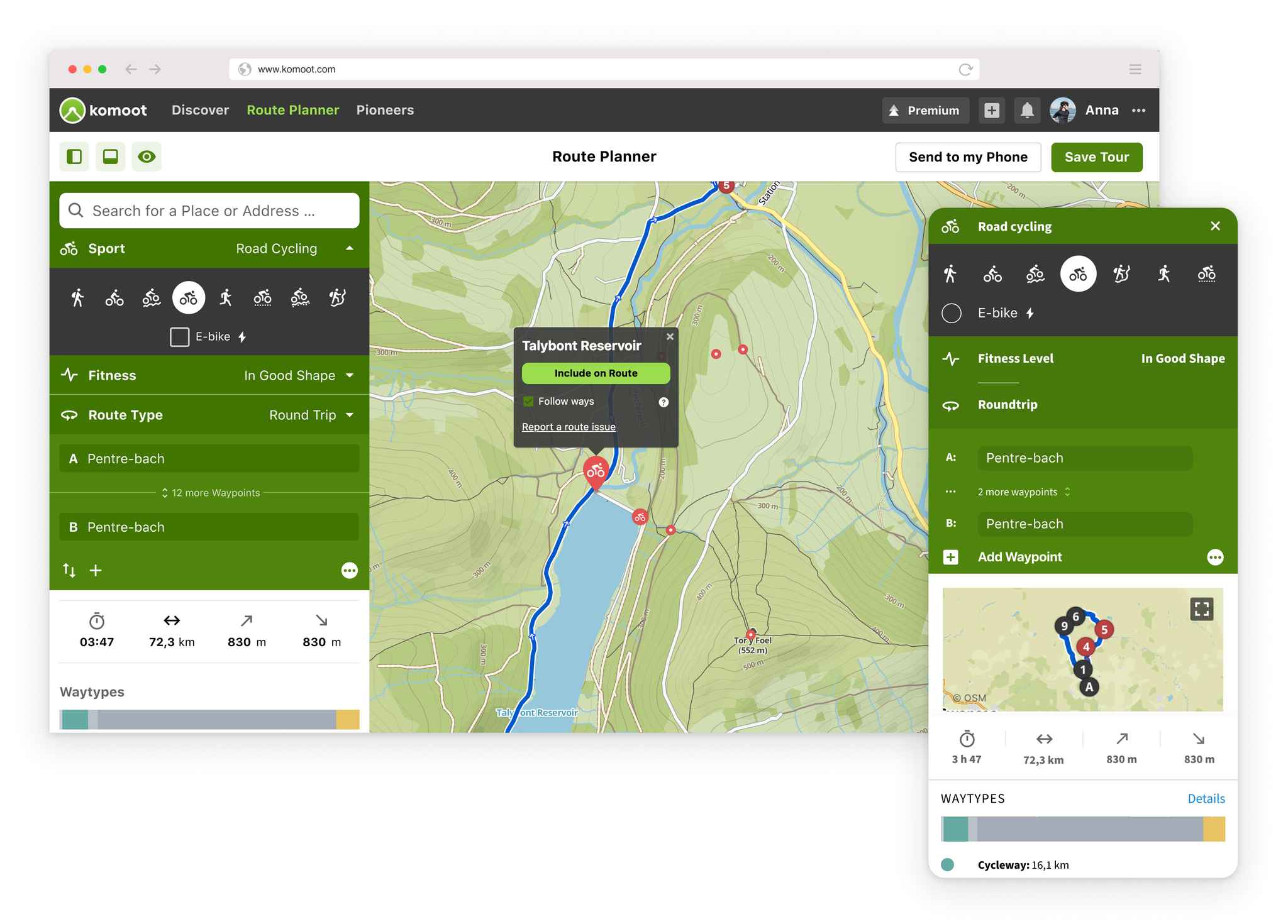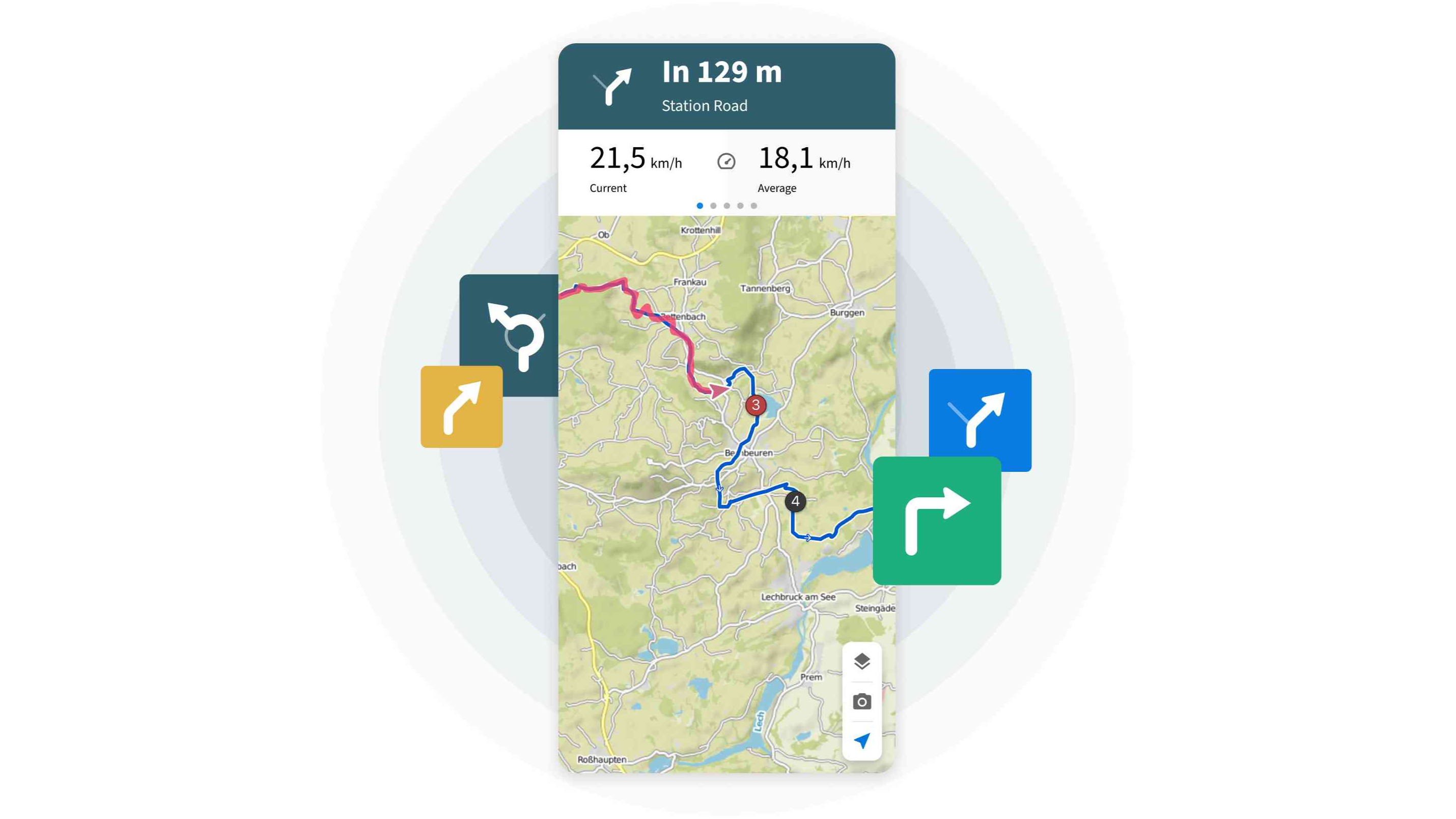Komoot vs Strava: Which cycling app is best?
Explaining the similarities and differences between two of the most popular cycling apps

I couldn’t count on 10 hands how many times I’ve heard a cyclist talking about Strava KOMs. The term has become as commonplace as the words ‘peloton’ and ‘watts per kilo’ in cycling. And while Strava has been around for a while, and is certainly one of the most popular apps in cycling, it is not known for its route-planning. In step Komoot, which promises to change the game in cycling, exploring and bikepacking. The Komoot app is arguably the best route-planning app on the market it does miss out on a few key training features. Both apps are free, by the way, although they do offer premium subscriptions which unlock the full range of app features.
In this guide, we’ll explain the difference between Komoot and Strava, and why you might choose one app over the other.
Komoot
Komoot is a route-planning and navigation app designed to provide the best variety of routes based on ride type, road surface, and the overall difficulty. Komoot’s app and website are known for being easy to use and simple to adjust – you simply input a start point and endpoint, and Komoot will generate a number of route options for you.
These routes are based on what type of riding you’d like to do, as well as any stopping points that you’d like to add. The options cover quick road rides, winding backroads, gravel rides, mountain biking, or even hiking or walking. All the routes are calculated by Komoot’s unique algorithm, with each option displaying ride stats including distance, elevation, estimated time to completion, and even a surface-by-surface breakdown of gravel, road, single-track, bike path kilometers and more.
Once you’re out for a ride, you can navigate through these routes without an internet connection; but if you do have a connection, you can reroute your ride in real-time. It must be noted that to get the offline directions, as well as turn-by-turn directions, you need to make a one-time payment to unlock the region you are riding in. A single region, which only covers your local area, costs $3.99 / £3.99, a region bundle costs $8.99 / £8.99 and the world pack is $29.99 / £29.99.
The Komoot community is unlike Strava’s – as we’ll get into shortly – but it is still strong and abundant with ‘Highlights,’ which are neat places to see or visit, as chosen by fellow Komoot users.
Komoot uses OpenStreetMap to support its mapping database and then uses its own algorithms to curate a number of different routes. Once you’ve sorted through the options and chosen your route, you can use Komoot with onscreen and audible navigation offline, or send the route to a compatible cycling computer or head unit device. While riding, Komoot will show you a few metrics including speed, distance traveled, and distance to go.
To get full access to Komoot's features like sport-specific maps, multi-day planner, weather and live tracking you will need a premium account. The Komoot premium account costs $59.99 / £59.99 per year and is billed monthly.

Strava
Strava is an activity sharing app and website that allows users to track and upload their workouts and activities using GPS, heart rate, and power data. Files can be uploaded directly from the Strava app, or from a third-party GPS computer, smartwatch, or other fitness devices.
What separates Strava from other fitness apps is its massive community. There are millions of Strava users and subscribers all across the globe, who track every kind of activity from cycling and running, to rowing and hiking. Users have access to the library of Strava leaderboards, which is what truly put Strava on the map. These leaderboards are made up of segments that award the fastest finisher a King of the Mountain (KOM) or Queen of the Mountain (QOM), and a digital crown for that segment. Strava KOMs are one of the most contested prizes in cycling after the rainbow bands or maillot jaune.
Strava also has its own route builder which attempts to enter into Komoot’s area of expertise. Users can click through the Strava app, or create their own route on the Strava website, before uploading it to their bike computer or head unit and setting off on a ride. The ease of use and connectivity is one of Strava’s best features.
However, the biggest sticking point for Strava is that you now need to pay the Strava premium subscription ($6 / £6.99 per month, or $59.99 / £47.99 per year) to access Strava’s route-planning feature. With the premium subscription, you also get access to Strava training plans and fitness tracking which allows you to see your fitness trends over time, as well as analyze heart rate and power data from different activities. A premium account will also give you access to its full range of leaderboards.
Furthermore, Strava routes do not have ‘Highlights’ like Komoot routes, but Strava does have a unique ‘heatmap’ that shows you which routes and roads are most popular in a given area. It’s a useful feature for discovering new routes and can be especially helpful for commuters, but it's not as easy to navigate as Komoot’s route-planning system, nor does it suggest route options from Point A to Point B. The auto-routing is based on its huge library of data which is pretty reliable although that doesn't mean they are necessarily the best ones, and it’s hard to know what you’re missing out on that might be off the beaten path.
Similarities and differences
While Strava does have a few elements of social media – such as the ability to give ‘kudos’ to other riders and upload photos from your ride – there is always a competitiveness to the app and an urge to compare yourself to others. Strava is a world filled with numbers – distance, speed, elevation, and power. These are all trackable metrics for your own use, but you can’t help but wonder what everyone else is doing. Right in the app and on the website, Strava displays exactly what everyone else is doing. Instead of just the map alone, you’ll see other rider stats from max power to average speed.
Conversely, Komoot is all about the ride experience. On the Komoot maps, you’ll notice a number of red bike icons scattered across the landscape. These are ‘Highlights’ that other riders have pointed out that may be helpful to others. Sometimes it’s a beautiful view, or a local café. By simply clicking on the icon, you can add these stops to your route.
You can also upload your own highlights, as well as upvote or downvote others’ highlights, adding a bit of a social media touch to Komoot. Strava, on the other hand, has its ‘Kudos’ feature, as well as the ability to follow other users and comment on their rides. Of course, you don’t have to be followed if you don’t want to, so you can set your user profile to either public or private.
One of the biggest differences between Strava and Komoot are the infamous Strava segments, leaderboards, and KOMs/QOMs. While Komoot is more of an exploring, planning, and sharing app, Strava has a much stronger sense of competition. The Strava world is filled with millions of users trying to best each others’ times on Strava segments, The segments are created by users - you have to have ridden it to be able to create a segment - and are automatically curated when you finish a ride. Strava breaks these down into a whole host of leaderboards so you can compare your times against your previous times, friends, clubs or every rider on Strava. It's not entirely about speed though, Strava awards consistency too with its Local Legends feature. To become a local legend of a segment you must complete it the most times in a 90 day period.
Komoot is a great app for adventuring and ride-planning because of its Waytypes feature. The Waytype summaries provided by Komoot are a truly unique and helpful feature for all kinds of cyclists. These maps will tell you exactly how many kilometers of your route are city streets, cycleways (bike paths), single-track, gravel roads, asphalt, and more. This is an incredible feature for not only exploring but also for commuters and route optimization. By inputting a start point and endpoint, you could discover a whole new set of roads or routes that could help you reach your destination. I can’t tell you how many rides I’ve done on new-to-me roads that turned out to be rough gravel or dirt – I had set out on a road bike, and had no choice but to turn around. Komoot could change that, allowing you to plan ahead and tailor your bike and tires to the upcoming terrain.
While Strava doesn't distinguish routing by bike type, it can identify surface type and the routing tool can be told what surface preference you have whether that's on-road, off-road or a mixture. You can also choose how much elevation you want and Strava will attempt to minimize or maximize elevation.
Both Komoot and Strava allow you to upload GPX, TCX, or FIT files, which you can then save as a completed activity, or upload to the route planner where you can then modify it before your next adventure.
Komoot and Strava are available on desktop, as well as iOS and Android.
How to choose
Strava is a more competitive and fitness-driven app than Komoot, making it ideal for competitive athletes and those who want to challenge themselves to reach their fitness goals. There is a sense of competition surrounding Strava, one in which many find themselves chasing endless amounts of Strava segments. But there is also a supportive community and healthy spirit of competition that can motivate you much more than general riding. Heatmaps are a very useful feature when route planning to see where others have gone too.
Ultimately Strava really nails the social media that's possible on an activity tracking platform. If you want to compare data with yourself and others then it's the best. It also covers loads of other sports too from running to skiing so you can track and share all your activities in one place.
Komoot is about exploring, riding, and seeing the world. The highlights and Waytype summaries on Komoot make it one of the best apps for route-planning, touring the countryside, or taking a trip into the city to explore. Without segment leaderboards or badges, there is less of a competitive edge to Komoot, which is more about sharing your experience rather than challenging others.
Commuters, gravel riders, bikepackers, and those who love to ride will absolutely adore Komoot. The app is clean, smart, and easy to use, and while setting up your ideal multi-surface route, Komoot will show you some incredible highlights that you might have otherwise missed.
In addition to elite-level road, track and Zwift racing, Zach Nehr is a freelance writer and the head of ZNehr Coaching. He contributes written articles on a variety of cycling-related subjects, including product reviews and advertorials, as well as feature articles and power analyses. With a Bachelor’s Degree in Exercise Science from Marian University-Indianapolis, Zach spends his time working with endurance athletes of all ages and levels at ZNehr Coaching. Having entered the sport at age 17, Zach has had a successful racing career, winning the 2017 Collegiate National Time Trial Championships and a 9th place finish at the 2019 US Pro National Time Trial Championships. These days, Zach spends most of his ride time indoors, racing on RGT Cycling and competing in the Zwift Premier League with NeXT eSport.



